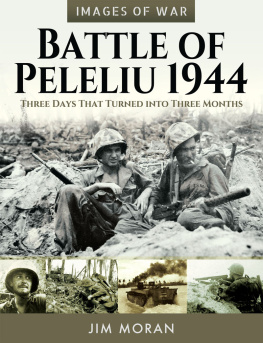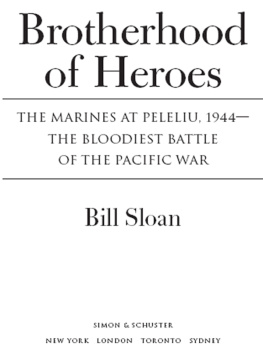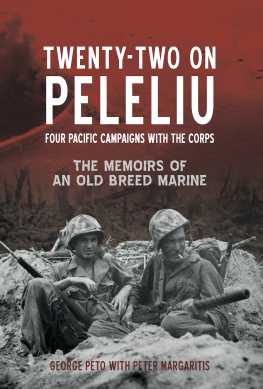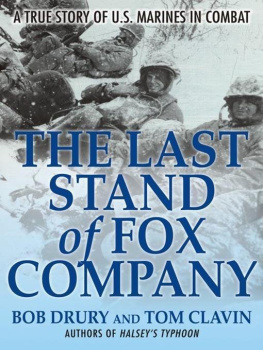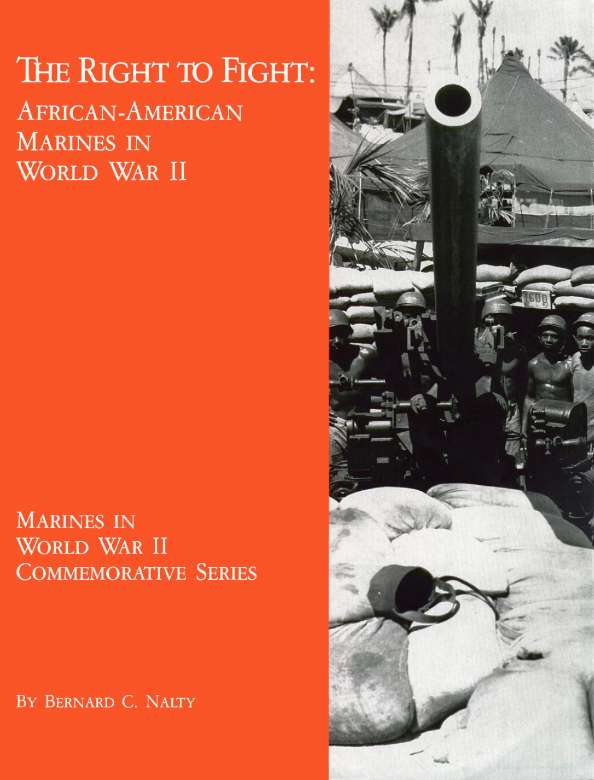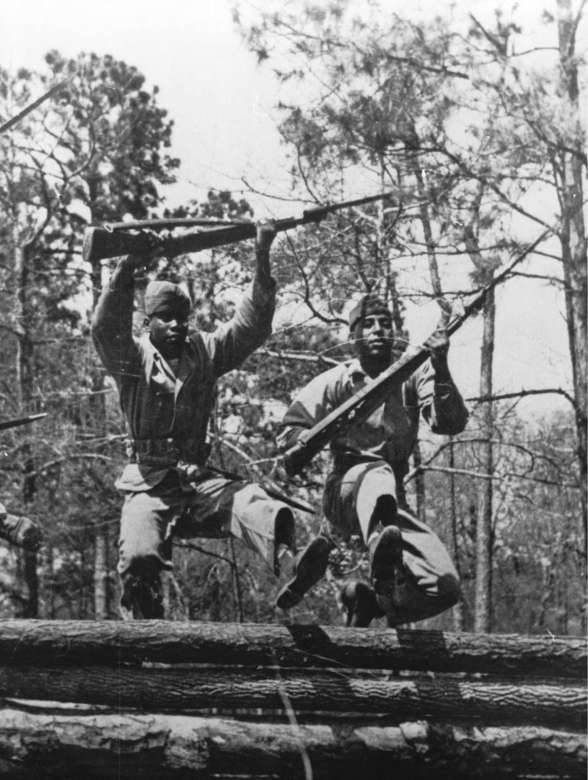
The Right to Fight:
African-American Marines in World War II
by Bernard C. Nalty
young white Marine,
AEdward Andrusko of Company I, 7th Marines, saw his first I black Leathernecks as he crossed the beach at Peleliu in September 1944, returning to the fight after having his wounds treated at a hospital ship offshore. The African-Americans were transferring ammunition from landing craft onto trucks and delivering it to the front lines. Handling ammunition struck him as "a dangerous task at any time," but with enemy shells churning the coral sands, "it was a heroic, thankless job that few of us wanted." The black driver of one of the trucks offered a ride inland, and Andrusko accepted, taking his place in the cab, with a cargo of high explosives behind him. As the sound of battle drew nearer, he concluded that he had made "a stupid and dangerous choice of transportation," but he reached his unit safely.
Andrusko again saw the African-American Marines after his company, advancing through the island's rugged terrain, encountered concealed Japanese positions and came under fire that pinned the men down. With the company's first sergeant and another Marine, he set out to find riflemen to take the place of casualties and stretcher bearers to carry off the wounded and dead. The first Marines that Andrusko and the others found proved to be members of the
On the Cover: A veteran 90mm crew of the 51st Defense Battalion poses with its gun, "Lena Home" at Eniwetok in 1945. Department of Defense Photo (USMC) 121743
At left: Men of Montford Point clear an obstacle on the way to earning the right to serve in the U.S. Marine Corps.
very unit he had met on the beach, and the blacks immediately volunteered to help. Andrusko's first sergeant had no idea that African-Americans were serving in the Marine Corps, so complete was the segregation of the races, but he welcomed their aid. The black Marines moved forward to the tangled ridges where Company I was fighting, carried away the casualties during the afternoon one of the wounded compared them to "black angels sent by God"and manned empty foxholes to help beat back a nighttime Japanese counterattack.
When Andrusko encountered the men of the ammunition company, few white Marines knew that African-Americans had been serving in the Corps for more than two years. The leadership of the Marine Corps had shown scant enthusiasm for accepting African-Americans, who had to overcome the barrier of racial prejudice as they struggled for the right to serve. But serve they did, ably and gallantly.
Basic Racial Policy
When the United States began arming against aggression by the Axis powers Nazi Germany, Imperial Japan, and Fascist Italythe Marine Corps had a simple and inflexible policy governing African-Americans: it had not accepted them since its reestablishment in 1798 and did not want them now. In April 1941, during a meeting of the General Board of the Navya body roughly comparable to the War Department General Staff the Commandant of the Marine Corps, Major General Thomas Holcomb, declared that blacks had no place in the organization he headed. "If it were a question of having a Marine Corps
of 5,000 whites or 250,000 Negroes," he said, "I would rather have the whites."
Whereas General Holcomb and the Marine Corps refused to accept African-Americans, the Navy admitted blacks in small numbers, but only to serve as messmen or stewards. The forces of change were gathering momentum, however. President Franklin D. Roosevelt, after meeting in September 1940 with a panel of black leaders, offered African-Americans better treatment and greater opportunity within the segregated armed forces in return for their support of his rearmament program and his attempt to gain an unprecedented third term in the November Presidential election. Roosevelt won that election with the help of those blacks, mainly in the cities of the North, who could still exercise the right to vote, and he did so without antagonizing the Southern segregationists in the Senate and House of Representatives whose support he needed for his anti-Nazi foreign policy.
By the spring of 1941, many black leaders felt that the time had come for the Roosevelt administration to make good its pledge to African-Americans, repaying them for their help. A. Philip Randolph, president of the Brotherhood of Sleeping Car Porters, a union made up exclusively of blacks, forcefully reminded the Chief Executive of this promise, threatening a march on Washington by as many as 100,000 African-Americans who would demand their rights as citizens. Roosevelt forestalled the march by issuing in June an executive order banning racial discrimination in hiring by defense industries under contract to the federal
African-Americans and the Marines
The estimated 5,000 blacks, free men and slaves, who served the American cause in the Revolutionary War included at least a few Continental Marines. For example, in April 1776 Captain Miles Pennington, Marine officer of the Continental brig Reprisal, recruited a slave, John Martin (also known as Keto), without obtaining permission from the slaveholder, William Marshall of Wilmington, Delaware. Private Martin participated in a cruise that resulted in the capture of five British merchantmen, but died in October 1777, along with all but one of his shipmates, when Reprisal foundered in a gale.
Two other blacks, Isaac Walker and a man known only as Orange, enlisted at Philadelphia's Tun Tavern in a company raised by Robert Mullan, the owner of the tavern, which served as a recruiting rendezvous for Marines. Captain Mullan's company, part of a battalion raised by Major Samuel Nicholas, crossed the Delaware River with George Washington on Christmas Eve 1776 and fought the British at Princeton. The wartime contributions of the black Continental Marines, and the other blacks who served on land or at sea, went unrewarded, for the armed forces of the independent United States sought to exclude African-Americans.
For a time, a militia backed by a small regular Army both made up exclusively of whites seemed force enough
to defend the nation, but tensions between the United States and France resulted in the building of a fleet to replace the disbanded Continental Navy. In 1798, when the time arrived to recruit crews for the new warships, the Navy banned "Negroes or Mulattoes," grouping them with "Persons whose Characters are Suspicious." The Commandant of the reestablished Marine Corps, Lieutenant Colonel William Ward Burrows, followed the Navy's example and barred African-Americans from enlisting, although black drummers and fifers might provide music to attract potential recruits.
The Marine Corps maintained this racial exclusiveness until World War II. Its small size enabled the Corps to recruit enough whites to fill its ranks, but other considerations may also have helped shape racial policy. Marines maintained order on shipboard and at naval installations, and the idea of blacks exercising authority over white sailors would have shocked a racially conscious America. The Marine Corps, moreover, had a sizable proportion of Southern officers, products of a society that had held black slaves. Not even the Northern victory in the Civil War, which enforced emancipation, could bring the races together in the former Confederacy. Jim Crow, the personification of racial segregation, rapidly imposed his grip on the entire nation, assuming the force of law in 1896 when the Supreme Court decided Plessy v. Ferguson and, in effect, isolated blacks from white society.



